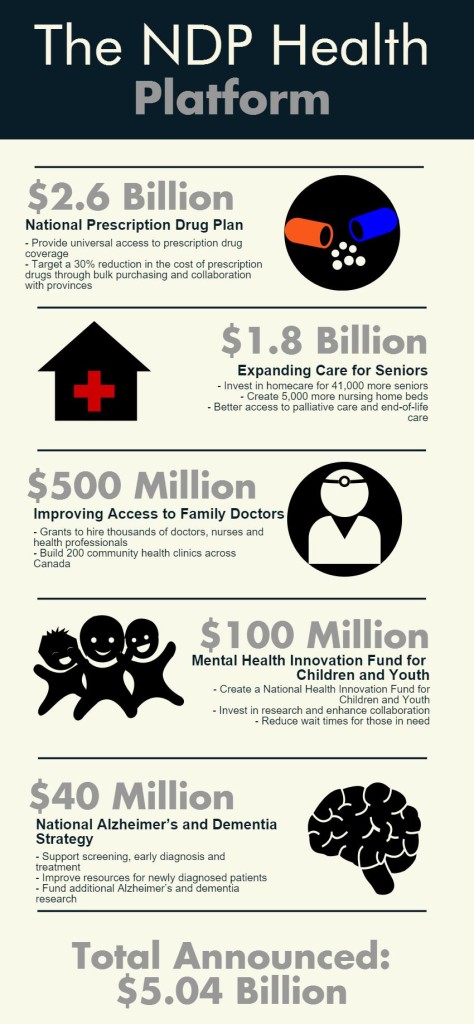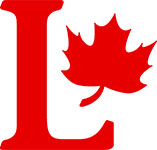In a campaign where the public has identified health care, particularly for seniors, as a priority issue, the federal party leaders have generally avoided the issue. Until last week, health announcements were few and far between.
That changed with the NDP breaking away from the rest of the parties androlling out its health care platform in concert with its fiscal plan over the course of the last week. The fiscal plan proposes increased incremental health care spending of $5.3 billion over four years, funded by increases to corporate tax rates, repealing both income splitting and the doubling of TFSA contributions, and closing stock option loopholes.
What about the Canada Health Transfer?
In 2011, the Conservatives announced that the Canada Health Transfer (CHT) escalator would drop from 6% to the rate of nominal GDP growth (with a floor of 3% growth) beginning in 2017-18. The NDP have consistently called this a cut and have vowed to restore it. Early in the campaign, NDP Leader Tom Mulcair stuck to this messaging, but hedged his position, saying that while it was a “top priority,” the funding would not happen right away and that an NDP health minister would have two years to get new health accords with the provinces.
In the NDP fiscal plan, four surplus budgets are projected, creating opportunity for the NDP to honour its commitment to fill the fiscal gap of the CHT. Looking at the fiscal plan, the NDP’s projected incremental spending from 2017-18 through to 2019-20 align closely with estimates of the funding loss under the CHT escalator reported by the Canadian Federation of Nurses Unions in July 2015.
But how do the NDP campaign commitments factor into the fiscal plan? The policy announcements made to date account for about 94% of the NDP’s incremental spending, leaving little cash on the table to go directly to provinces. The answer: establishing conditions on increased health care funding from an NDP federal government.
“We have committed to continue the six per cent escalator but I do want to be clear that some of that six per cent will include announcements on healthcare that our leader Tom Mulcair has already made this week,” said NDP candidate Peggy Nash. (CTV News, September 16, 2015)
With a future view to negotiating a new health accord with the provinces, it remains to be seen which of the NDP’s health policies will be part of the increases in the CHT. Policies like the National Prescription Drug Plan appear to be prime candidates for being part of a new health accord and its funding deal.
However, at this point the NDP’s intent on what would be included in a health accord negotiation is not clear. The bulk of incremental health spending on the announced policies occurs in years three and four of an NDP mandate, which would come after the conclusion of a health accord negotiation. But with health care delivery the responsibility of the provinces, which face different challenges related to an aging population, it remains to be seen whether they will accept NDP program conditions on funding.
National Prescription Drug Plan: A Closer Look
The biggest program announced by the NDP was the $2.6 billion commitment to implement a National Prescription Drug Plan. While not called pharmacare, the plan’s announcement was warmly received by many pro-pharmacare advocates on social media and received support from the Canadian Federation of Nurses Unions, Ontario Federation of Labour, Canadian Doctors for Medicare, Canadian Cancer Society and Canadian Pharmacists Association.
However, the plan is short on details of what this plan will look like and what progress will be achieved over the course of a four-year mandate. Here’s what we do know about the fiscal measures of the plan:
- $2.6 billion in new federal funding
- To be phased in over four years
- Potential to generate $3 billion in savings at provincial level
- Does not depend on matching funds from provinces
When looking at the plan from an operational point of view, the picture formed is much less clear. The plan is built around “consultation with the provinces to work towards a plan to support universal comprehensive public drug coverage for all Canadians” and committing to work with the provinces to develop a program based on the key principles of:
- Work to ensure every Canadian, regardless of age or health condition, will be included
- Reduce prescription drug prices through proven, evidence-based policies
- Improve public drug coverage in every province
The language around working in consultation and with the provinces indicates that there could be much negotiation ahead for the National Prescription Drug Plan. Early and somewhat easy wins for the plan could come from federal involvement in the Pan-Canadian Pharmaceutical Alliance and leveraging bulk purchasing through that initiative to further drive down prices. The NDP have targeted a 30% price reduction, which could result in a potential savings of $3 billion to the provinces.
Looking at the NDP’s policy document on better access to prescription drugs, more policy direction emerges, including working with the provinces to establish a common list of drugs to be covered and using common bargaining power in purchases. Absent from the campaign plan, but included in the policy document are commitments for the federal government to review how the Patented Medicine Prices Review Board establishes the price of new drugs and ensuring that trade agreements do not drive up drug costs.
One element of the plan which did not receive much coverage, yet has potential to be significant in shaping the future plan is a commitment of $80 million over four years to improve provincial-federal capacity for drug reviews, listing, joint pricing negotiations and improving safety by reducing inappropriate prescribing. These undefined measures, depending on who influences them and how they are implemented, potentially have a significant impact on the review of new medicines for cost-effectiveness and reimbursement environment in Canada.
The Takeaway
The NDP broke away from the pack on health care this past week by announcing its health platform and providing an initial look at the spending associated with it. However, with the commitment to restore the Canada Health Transfer and establish a new health accord with the provinces, there will be much negotiation ahead required to define these programs and implementation may be delayed until later years of an NDP mandate. The question on October 19 is whether the promise of progress on these plans over the course of a potential four-year mandate is enough to satisfy the immediate health care concerns of Canadian voters.





